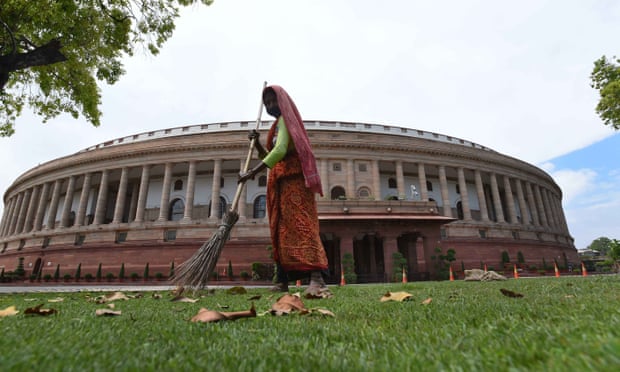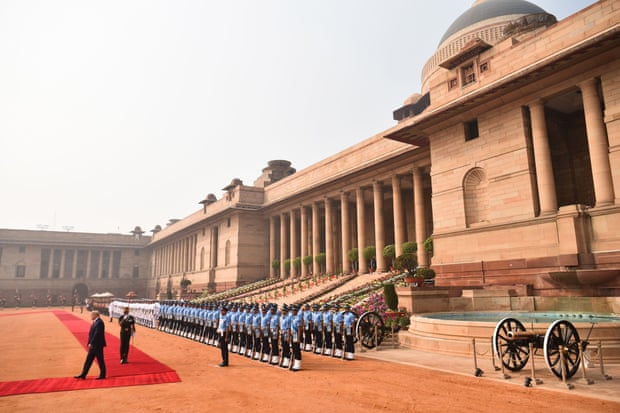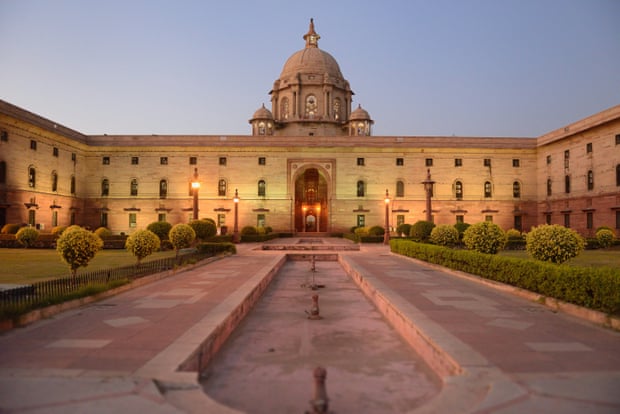Anish Kapoor among those pouring scorn on redevelopment of Lutyens’ central vista, branding it an act of ‘political fanaticism’
It was built by Sir Edwin Lutyens as the grand imperial heart of India, then reclaimed as the seat of power for an independent republic.
Now, government plans to redevelop Delhi’s emblematic central vista and build a new parliament have drawn fierce criticism.
Writing in the Guardian, the acclaimed Indian-born sculptor Anish Kapoor has described the plans to rebuild the nation’s power corridor as an act of “political fanaticism” by Narendra Modi, India’s Hindu-nationalist prime minister.
The “expensive vanity project”, Kapoor writes, is Modi’s “way of placing himself at the centre and cementing his legacy as the ruler-maker-builder of a new Hindu India”.
The project, added Kapoor, is going ahead “without an articulated architectural position, public consultation, parliamentary debate or peer consent”.

Delhi’s central vista, home to the grand complex of government buildings, is one of the most recognisable sites in India. The long and grassy avenue sweeps down from the India Gate war memorial to the Rashtrapati Bhavan, or president’s residence, with the circular Parliament House building in between. It was designed by British architects Lutyens and Herbert Baker following the 1911 decision to move the capital of the British Raj from Calcutta to Delhi.
The geometric design, with wide avenues and sprawling lawns, was modelled on European capitals such as Paris but was also infused with Indian influences from the architecture of Hindu temples to the red-stoned grandeur of Mughal forts. The vista remains the only area in India designated grade 1 heritage status.
Now, under a $3bn development plan, over the next four years an entirely new triangular parliament building will be erected next to the current heritage Parliament House, which was built in 1929, as well as a new residence for the prime minister. It will repurpose the north and south blocks into a national museum, demolish some newer ministry buildings and erect a vast new secretariat along either side of the vista, which will house all the government ministries currently scattered across Delhi. It will be the most significant transformation of the physical structures of government in India since independence; yet according to many opponents, it is not needed at all.
The government and HCP Design, the architecture firm overseeing the project, say its necessity is not up for dispute. “From the day after independence, parliament was too small, because the existing building was the council house for the British raj,” said Bobby Desai, director of design at HCP. “We have limped along since then. It was certainly never designed to be a parliament building for a country of 1.4 billion people.”
Currently 550 representatives sit in the parliament, but is still based on the 1971 census when India’s population was a just 580 million, meaning a single elected official now looks after an average of 2.5 million people. This will be up for review after 2026 and there are estimates it could raise the number of parliamentarians to over 900, thus requiring more seats.
But opponents to the project have questioned why the Indian government cannot follow the example of ageing parliament buildings all over the world, from the French parliament to the Houses of Parliament in the UK and the Senate in the US, and renovate the current structure, which is less than 100 years old.
Desai insisted that it was unsafe to do so, and that an entirely new building was the only option. “The current building has heritage status and physically can not be expanded any further, without being incredibly invasive,” he said. HCP say their design will also create 75 acres more of public green space, including part of presidential estate being opened up for the first time as an arboretum showcasing India’s biodiversity.
With Delhi currently the most polluted city in the world, many have questioned why there are funds for this grandiose development but not to clean the city’s toxic air. The coronavirus pandemic, and the massive financial strain it has put on India and its millions of migrant workers, has led many to argue that the billions could now be better spent on urgently needed healthcare and welfare. However, a petition for the vista development to be delayed due to the pandemic was rejected by the Supreme Court last week.
“Everything about this project has been flawed,” said Anuj Srivastava, an architect who has been part of Lokpath, a group opposing the development. “There has been no transparency, no consultation and they are pushing forward with it so fast just so they can get it done before the next election. It’s clearly nothing but a vanity project for prime minister Modi, to build parliament in his own image, at an unaffordable cost..
“A heritage area like this is under strict architectural control but that seems to have been completely disregarded,” Srivastava added. “The government is riding roughshod over all the committees and bodies which are supposedly meant to protect this area.”
The selection process that awarded the project to HCP, a firm known for their close ties to Modi, was accused of a lack of transparency.
Desai acknowledged that there had been “objections” to the lack of public consultation on a project. “I’m not saying we have absolutely achieved the mark of how public consultation should happen in these projects,” said an HCP project spokesperson. “I think there is some lack from both ends, both from us and also from the end of the government.”
Historian Sohail Hashmi said the project was problematic on both a practical and symbolic level. For the first time, it will see all government buildings concentrated in a single place. “We should be talking about distributing power and instead we have a design which will be the very embodiment of the concentration of power,” said Hashmi. “A monument to a crazed dictatorial desire to have all government in one place, under the watch of one man – our prime minister.”



